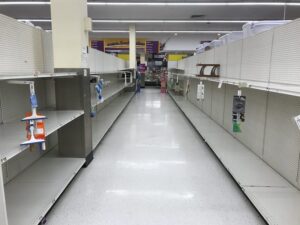What happened to all the toilet paper?[1]
The COVID-19 pandemic created conditions that required business to react quickly to unpredictable changes. When the pandemic began, many businesses were stuck with billions of dollars in unsold goods and later had to figure out what to do with those goods. But the demand for toilet paper dramatically increased.

Stay-at-home orders led to a sudden 40-percent increase in demand for retail toilet paper, the fluffier kind typically found in homes.[2] But supply cannot adjust overnight to meet demand. Toilet paper takes up a lot of physical shelf space and demand is usually very stable. Retailers usually kept only two to three weeks worth in inventory.[3] In addition, manufacturers usually operated their factories at 92-percent capacity. Worried they would be left without toilet paper while stuck at home, Americans cleaned out store shelves.
How did U.S. toilet-paper manufacturers respond to the shortages? None added production lines or built new plants to expand capacity. This is because the toilet-paper manufacturing process is highly mechanized, requiring four-story-tall machines that cost billions of dollars and months to assemble before a single roll can be made.[4] While U.S. manufacturer of cleaning products quickly pivoted to produce more cleaning wipes and hand sanitizer,[5], very few toilet paper factories that produced scratchier commercial toilet paper were converted to produce the retail kind consumers wanted.[6] Nor did many sell commercial toilet paper to households.
Instead, manufacturers used their existing processes and increased production as much as they could. They ran plants at nearly 100-percent capacity. Some streamlined their product offerings, in particular, shifting to large-roll products that could get more paper to households without costly changes to machinery. Others invested in their distribution systems, so that they could anticipate and respond more quickly to local shortages. These kinds of responses from manufacturers helped to shorten the stressful period of empty store shelves.
- Adapted from Helper, Susan, and Evan Soltas. “Why the Pandemic Has Disrupted Supply Chains.” The White House, June 17, 2021. https://www.whitehouse.gov/cea/written-materials/2021/06/17/why-the-pandemic-has-disrupted-supply-chains/. ↵
- Schrotenbeor, Brent. “Coronavirus and Shopping for Supplies: Getting to the Bottom of the Toilet Paper Shortage.” USA TODAY, April 8, 2020. https://www.usatoday.com/story/money/2020/04/08/coronavirus-shortage-where-has-all-the-toilet-paper-gone/2964143001/. ↵
- Wieczner, Jen. “The Case of the Missing Toilet Paper: How the Coronavirus Exposed U.S. Supply Chain Flaws.” Fortune, May 18, 2020. https://fortune.com/2020/05/18/toilet-paper-sales-surge-shortage-coronavirus-pandemic-supply-chain-cpg-panic-buying/. ↵
- Terlep, Sharon. “P&G Toilet Paper Factory Keeps Delivering as Coronavirus Strikes Its Town.” WSJ, April 12, 2020. https://www.wsj.com/articles/p-g-toilet-paper-factory-keeps-delivering-as-coronavirus-strikes-its-town-11586707201. ↵
- Dalton, Matthew, Ruth Bender, and Jason Douglas. “Companies Retool Operations to Assist in Coronavirus Fight.” WSJ, March 19, 2020. https://www.wsj.com/articles/companies-retool-operations-to-assist-in-coronavirus-fight-11584637831. ↵
- Terlep, Sharon. “Toilet Paper Giant Pivots From Scratchy Office Rolls to Battle Home Shortages.” WSJ, April 23, 2020. https://www.wsj.com/articles/kimberly-clark-to-reassign-makers-of-office-toilet-paper-to-meet-demand-for-softer-stuff-11587577564. ↵